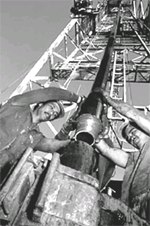The lost world
 the theories of how the continents were formed may have to be revised. Scientists have discovered a continent that rose above the Indian Ocean at least three times over a period of 80 million years, only to disappear beneath the waves every time. It has been discovered on the seabed about 4,000 kilometres south-west of Australia. According to geologist Mike Coffin of the University of Texas, usa, while he and his team were aboard the drilling ship Joides Resolution , which is working on an international drilling programme, they found that two submerged features, the Kerguelen Plateau and Broken Ridge, about 2,000 metres below the surface, were once joined. Together they formed a continental shelf of two million square kilometres.
the theories of how the continents were formed may have to be revised. Scientists have discovered a continent that rose above the Indian Ocean at least three times over a period of 80 million years, only to disappear beneath the waves every time. It has been discovered on the seabed about 4,000 kilometres south-west of Australia. According to geologist Mike Coffin of the University of Texas, usa, while he and his team were aboard the drilling ship Joides Resolution , which is working on an international drilling programme, they found that two submerged features, the Kerguelen Plateau and Broken Ridge, about 2,000 metres below the surface, were once joined. Together they formed a continental shelf of two million square kilometres.
Only a small part, no bigger than Britain, actually protuded above the surface. This land mass probably played a role in the migration of animals after the supercontinent of Gondwana broke up, which started about 130 million years ago. The new discovery shows that the break up, which gave rise to Australia, Antarctica and India, was much more "messy' than once thought, said Coffin. Marine geologists have suspected for more than a decade that the Kerguelen Plateau was part of an ancient continent. Now, samples drilled over the past two months have provided the first direct evidence. At Elan Bank, on the western side of the plateau near Heard Island, the geologist found garnet-bearing metamorphic rock, which forms at a high temperatures and pressures found in deep continental crusts. At other drill sites, layers of sediment were found containing plant spores, seeds, pollen, wood fragments and charcoal. Based on the plant remains and fossilised marine plankton, the researchers have identified three periods during which the crust rose above the sea level. The first was around 100 million years ago, when the southern end of the plateau rose above the surface. Part of the crust broke the surface again about 85 million years ago and again 35 million years ago, each time further north and involving a smaller amount of land.
Related Content
- Global hepatitis report 2024: action for access in low- and middle-income countries
- Measures to enhance forest conservation and reduce deforestation: viewpoints and lessons from producing countries
- Investing in reproductive, maternal, newborn, child, and adolescent health in Uganda: what have we learned, and where do we go from here?
- Loss and damage and agrifood systems: addressing gaps and challenges
- Africa’s pulse, October 2023: delivering growth to people through better jobs
- Air Quality Life Index (AQLI): annual update 2023
